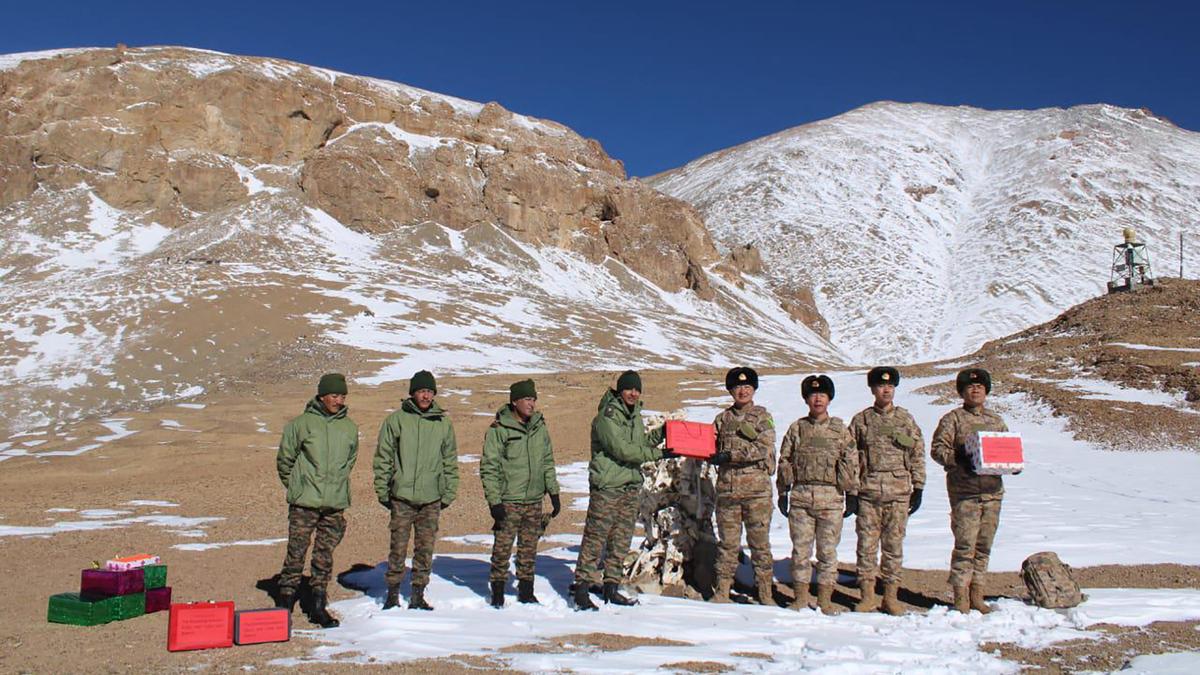Indian and Chinese soldiers at the Line of Actual Control, in Ladakh, in October 2024
| Photo Credit: AFP
India’s Foreign Secretary Vikram Misri was in China in January 2025, during which India and China made several announcements on the future of their bilateral relations. He met Wang Yi, who is China’s Foreign Minister, the Director of the Office of Central Commission of Foreign Affairs and also a politburo member of the party, and also Liu Jianchao, Minister of the International Department of the Chinese Communist Party.
The Indian statement after this meeting indicated that the process of restoration of several aspects of bilateral relations including media and think tank exchanges, the Kailash Mansarovar Yatra, and bilateral flights is on the cards for the summer of 2025.
Possible reasons
India and China have attempted to move forward after more than four years of tense and stalemate-based relations since the clashes in Galwan in June 2020. Stalemates cannot be permanent. Both sides have made their points and moved to the détente. One can argue that there are several reasons for the timing of this bilateral agreement, the main being the election of Donald Trump, who is a known disruptor and unpredictable in his ways of doing business. The other is about economic concerns in China and in India in recent times.
India and China have been bracing for the Trump impact especially when by the middle of October last year his election was already beginning to look more likely to happen. This possibility may have pushed the October 2024 de-escalation agreement between India and China, and Mr. Trump’s gigantic electoral victory in November 2024 may have pushed the January 2025 agreement between India and China. There is a historic logic to this as well. China agreed to normalising relations with India, after the 1962 war, only in the backdrop of the backlash in the aftermath of the 1989 Tiananmen Square massacre. Again, China may have agreed to normalise its relations with India given that it had to brace for the Trump impact. Thus, there is both internal and external logic around the restoration of normalcy.
However, since we do not know whether patrolling rights have been/are fully restored or whether demobilisation is in its advanced stages, such an absence of communication on the part of the government raises doubts and questions needlessly.
At the LAC
The Government of India has maintained absolute silence on the status of de-escalation, demilitarisation and demobilisation of the fairly large number of troops. Troops were mobilised and deployed on the border, first during the tensions of May-June 2020, and then in even larger numbers in the aftermath of the June 15, 2020 clashes. These troops were on active duty or in newly created barracks close to the six points of tension along the border including in Galwan, Depsang Bulge, Charding Nala, Gogra Post and Hot Springs and on the north bank of the Pangong lake.
There is also no clarity whether the large number of People’s Liberation Army troops on the Chinese side, before and after the clashes, have retreated to their bases. Confirmation of this would mean that the actual restoration of normalcy on the Line of Actual Control (LAC) has been achieved. India has also made it clear in the aftermath of 2020 that it was China that had violated the several agreements and protocols the two sides had signed. One is not sure about whether these have been rectified in a verifiable way. This in turn can only be established when patrolling rights have not only been agreed to but also exercised.
The briefing in October 2024, by the Foreign Secretary, prior to the 16th BRICS summit in Kazan in this respect, was already guarded. It only alluded to an agreement that would lead to the “process of disengagement and resolution of issues that emerged in 2020”. A follow-up briefing on this issue would have been useful and necessary to make it clear that India had not given up on its position on the bilateral relations.
India’s principled stand in dealing with China in the aftermath of the 2020 crisis has been that the stability on the border and the restoration of the status quo ante are the preconditions to progress in other aspects of bilateral relations. However, it was China that reiterated that India should move on from the clashes and not let the border standoff be a hindrance to the development of overall bilateral relations in the economic, political and social sectors.
The need for clarity
India’s silence on the progress on the status of restoration of status quo ante makes it appear as though the Chinese position of “moving on” is succeeding and that India is abandoning its position of stability and restoration before there is progress on other aspects. It was always known that the process of restoring normalcy would be long drawn and fraught with challenges. In addition, the worldviews of India and China will remain divergent as their ideas about the world order are not going to converge anytime soon. India-China relations have seen several cyclical ups and downs in the Xi Jinping era. Therefore, abundant caution would be the best way forward. The Indian government’s lack of clarity does not boost one’s confidence.
Avinash Godbole is professor and Associate Academic Dean at Jindal School of Liberal Arts and Humanities (JSLH), O.P. Jindal Global University
Published – February 21, 2025 12:08 am IST
